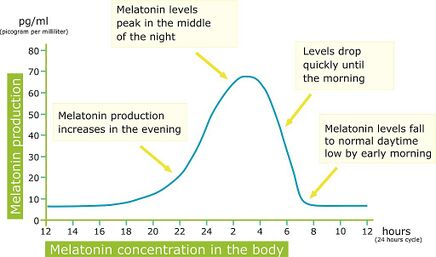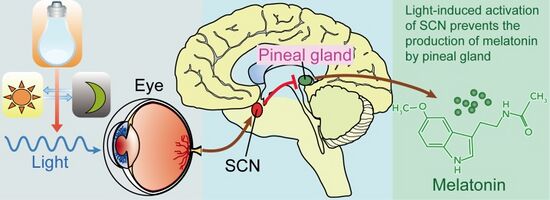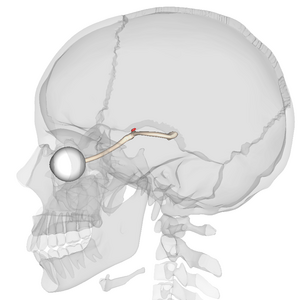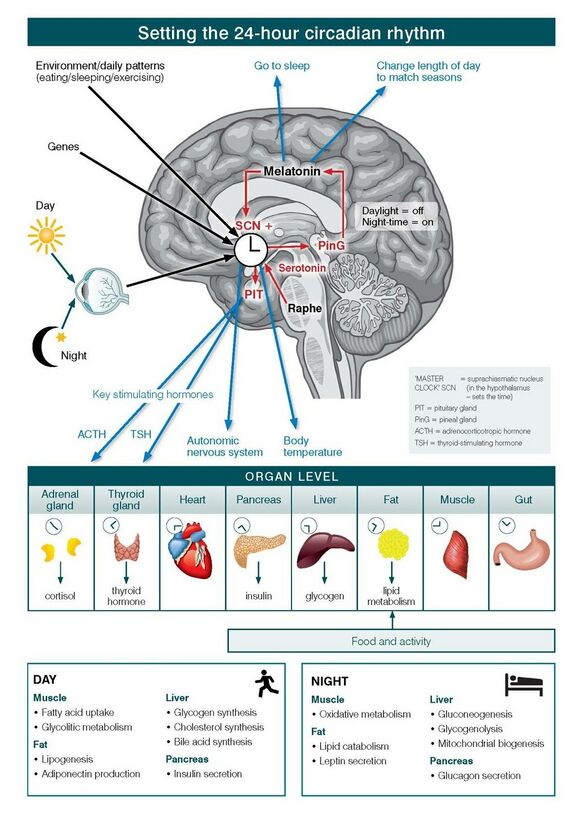Melatonin: Difference between revisions
No edit summary |
No edit summary |
||
| Line 34: | Line 34: | ||
== Physiotherapy Relevance == | == Physiotherapy Relevance == | ||
Good sleep hygeine is now recognised a major player in health. Sleep is important in helping to maintain overall day to day performance and overall well-being. It is also good to have an understanding of the importance of sleep and the immune response. Sleep is an important prophylactics to keep people's physical and mental state healthy. Keep informed of its relevance to our profession. by looking at these page for example [[Sleep: Theory, Function and Physiology]], [[Sleep: Regulation and Assessment]], [[COVID-19 and Sleep]] and other great read here [[:Category:Sleep|Category:Sleep]]. | |||
== References == | == References == | ||
<references /> | <references /> | ||
Revision as of 05:49, 9 August 2022
Original Editor - Lucinda hampton
Top Contributors - Lucinda hampton and Vidya Acharya
Introduction[edit | edit source]
Melatonin, mostly released by the pineal gland, is a circadian rhythm-regulated and multifunctional hormone. Great advances in melatonin research have been made, including its role in rhythms of the sleep-wake cycle, retardation of ageing processes, as well as antioxidant or anti-inflammatory functions. Melatonin production gradually declines with age, and its loss is associated with several age-related diseases.[1]
Roles of Melatonin[edit | edit source]
Include:
- Melatonin plays a crucial role in regulating sleep cycles by detecting light and dark through the retina. Melatonin is sometimes called the “Dracula of hormones” because it only comes out in the dark.[2]
- Melatonin has antiaging properties and modulates immune system function.Melatonin is effective in reducing oxidative stress. It achieves this action through scavenging free radicals such as reactive oxygen species (ROS) and indirectly by stimulating antioxidant enzymes while suppressing the activity of pro-oxidant enzymes[3].
- Melatonin plays an important role in oocyte maturation, fertilization and embryonic development as well. It binds to its receptors on the pituitary gland and the ovaries and appears to regulate the release of female reproductive hormones. Additionally, in certain mammals (other than humans), for example horses and sheep, melatonin acts as a breeding and mating cue, being produced in greater amounts in response to the longer nights of winter and less so during summer.[4][5][1]
Synthesis of Endogenous Melatonin[edit | edit source]
The hormone melatonin is produced naturally, synthesized, and secreted mainly in the pineal gland. Melatonin production begins with tryptophan, which in a multistep process is converted to serotonin in other parts of the brain. Some serotonin made makes its way to the pineal gland and is converted to melatonin in a regularly, light-dependent process. Melatonin is released from the pineal gland into the third ventricle and from there into circulation.
The conversion of serotonin to melatonin is controlled by the hypothalamus's suprachiasmatic nucleus (SCN), whose job is to control the body's circadian rhythms. Information about current light conditions travels from the retina along the retinohypothalamic tract to the SCN. From here signals are sent through the sympathetic nervous system to the superior cervical ganglia, which innervates the pineal gland[6].
The Master Circadian Clock.[edit | edit source]
Circadian systems need to be considered in relation to three differing levels of organization of information and operation.
- First, the physical environment communicates or ‘Inputs’ key information, particularly related to differentiation of night from day, to the internal ‘master’ clock (located in the brain’s suprachiasmatic nucleus (SCN)).
- Second, the ‘Intrinsic’ brain factors, consisting of the master clock and its linked regulatory systems (mainly secretion of melatonin from the pineal gland). These contribute to sleep onset, sleep architecture, sleep-wake cycles and other central nervous system-dependent behavioral changes.
- Third, the way in which the circadian system coordinates all other hormonal, metabolic, immune, thermoregulatory, autonomic nervous and other physiological processes to optimize the relationships between behavior and body functions, that is, the ‘Outputs’.
At the cellular level, almost all individual cells and organ systems have their own intrinsic clocks. As these cellular and organ-based clocks run to intrinsically different period lengths, the differing physiological systems have to be aligned in well organised patterns. Basically, the master circadian clock permits the organism to align key behavioral and intrinsic physiological rhythms optimally to the external 24-hour light–dark cycle.
Physiotherapy Relevance[edit | edit source]
Good sleep hygeine is now recognised a major player in health. Sleep is important in helping to maintain overall day to day performance and overall well-being. It is also good to have an understanding of the importance of sleep and the immune response. Sleep is an important prophylactics to keep people's physical and mental state healthy. Keep informed of its relevance to our profession. by looking at these page for example Sleep: Theory, Function and Physiology, Sleep: Regulation and Assessment, COVID-19 and Sleep and other great read here Category:Sleep.
References[edit | edit source]
- ↑ 1.0 1.1 Britannica Melatonin Available:https://www.britannica.com/science/melatonin (accessed 9.8.2022)
- ↑ Byjus Melatonin hormone Available:https://byjus.com/biology/melatonin-hormone/ (accessed 9.8.2022)
- ↑ Reiter RJ, Mayo JC, Tan DX, Sainz RM, Alatorre‐Jimenez M, Qin L. Melatonin as an antioxidant: under promises but over delivers. Journal of pineal research. 2016 Oct;61(3):253-78. Available: https://pubmed.ncbi.nlm.nih.gov/27500468/(accessed 9.8.2022)
- ↑ Yong W, Ma H, Na M, Gao T, Zhang Y, Hao L, Yu H, Yang H, Deng X. Roles of melatonin in the field of reproductive medicine. Biomedicine & Pharmacotherapy. 2021 Dec 1;144:112001. Available: https://pubmed.ncbi.nlm.nih.gov/34624677/ (accessed 9.8.2022)
- ↑ Wójtowicz M, Jakiel G. Melatonin and its role in human reproduction. Ginekologia polska. 2002 Dec 1;73(12):1231-7. Available:https://pubmed.ncbi.nlm.nih.gov/12722474/ (accessed 9.8.2022)
- ↑ Savage RA, Zafar N, Yohannan S. Melatonin.[Updated 2021 Aug 15]. StatPearls. 2021. Available:https://www.ncbi.nlm.nih.gov/books/NBK534823/ (accessed 9.8.2022)











